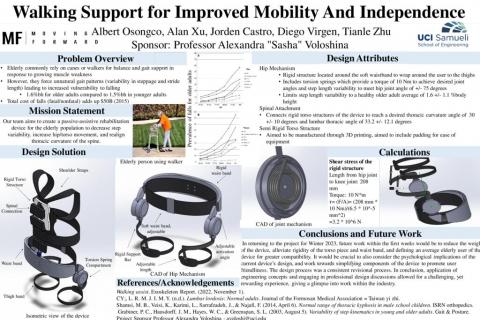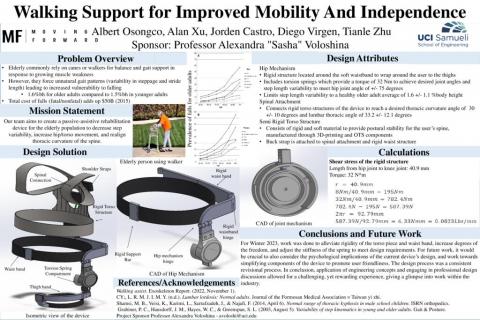Walking Support for Improved Mobility and Independence
Background
The elderly commonly rely on canes and walkers for balance and gait support. Similarly, crutches are commonly used after injury. All of these devices are cumbersome, force unnatural gait patterns, and greatly limit our arms. The goal of this project is to design a passive assistive device that will provide moderate support to users during gait, while not restricting arm use. Several exoskeleton designs have been proposed in research, but they tend to be heavy and actively controlled (i.e. with motors). They also are difficult to don and doff, which does not make them very user friendly. Being heavy, bulky, and uncomfortable causes the user to expend more energy wearing the exosuit leading to more issues down the road. Passive exosuits using soft materials rather than rigid components have surfaced in the industry improving the mobility of the abled bodied user, but not the people who actually need such help. Our team believes we can implement semi-rigid passive exosuits into the elderly community creating a more comfortable experience while still maintaining proper gait and balance.
Goals and Objectives
To mitigate fall risk and unhealthy gait patterns by creating an affordable and easy to use passive assistive exo-suit that improves gait and balance control in the elderly population. This is possible by focusing the attention of the device on the main areas of the body that provide balance and stabilty therefore improving gait. Issues such as inconsistent and variable stride frequency and stride length caused by muscle weakness will be alleviated.
For the winter quarter, the team aims to manufacture the device, using a combination of rigid and soft materials, both of which will be used in order to achieve goals of healthy lumbar lordotic angle and thoracic curvature angle. Additionally, the device aims to achieve the healthy joint angles from the knee and hip, from the use of the hip mechanism.
Design Goals
The use of combining soft materials with rigid is necessary in the design of a “semi-rigid” exosuit. This means ditching the conventional method of using strictly rigid components, which most times make it more labor intensive for the user especially if they’re elderly. Innovative textiles will replace some of these rigid structures usually around the joints of the lower body therefore making the design a lot less lighter as well as easier to wear. It can be argued that this design will be easier to implement into the elderly community simply because the asthetics look better in a social setting let alone giving any person with muscle weakness some healthy assistance.
Team Contact(s)
Jorden Castro - jordencc@uci.edu
Albert Osongco - aosongco@uci.edu
Alan Xu - alanx3@uci.edu
Diego Virgen - divirgen@uci.edu
Tianle Zhu - tianlz3@uci.edu
Sponsor/Advisor
Professor Alexandra S. Voloshina
Midterm Presentation: https://docs.google.com/presentation/d/1CxMaKVbC1ZCKDJjQF0tMFw-AmCE46ON5...



